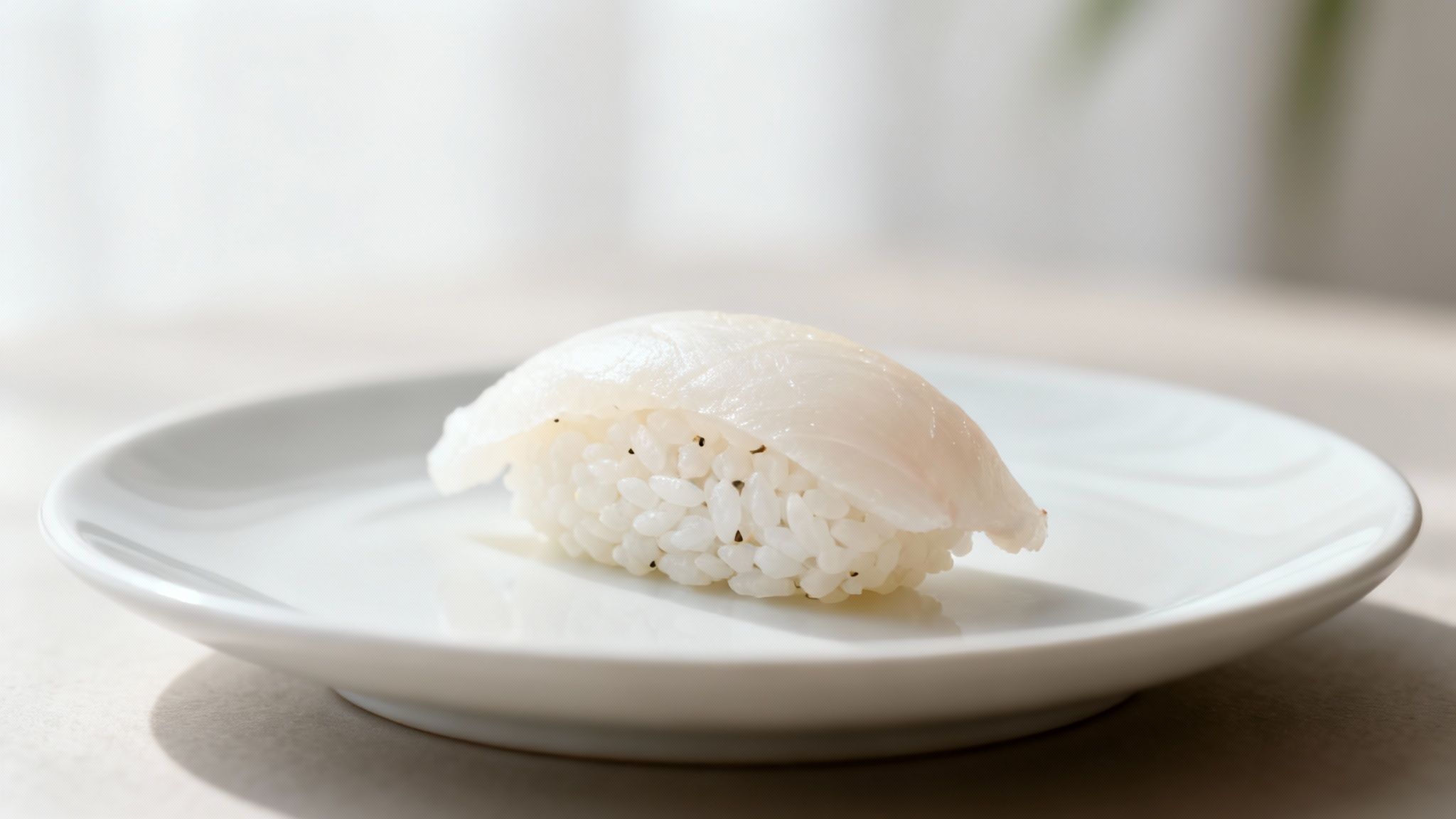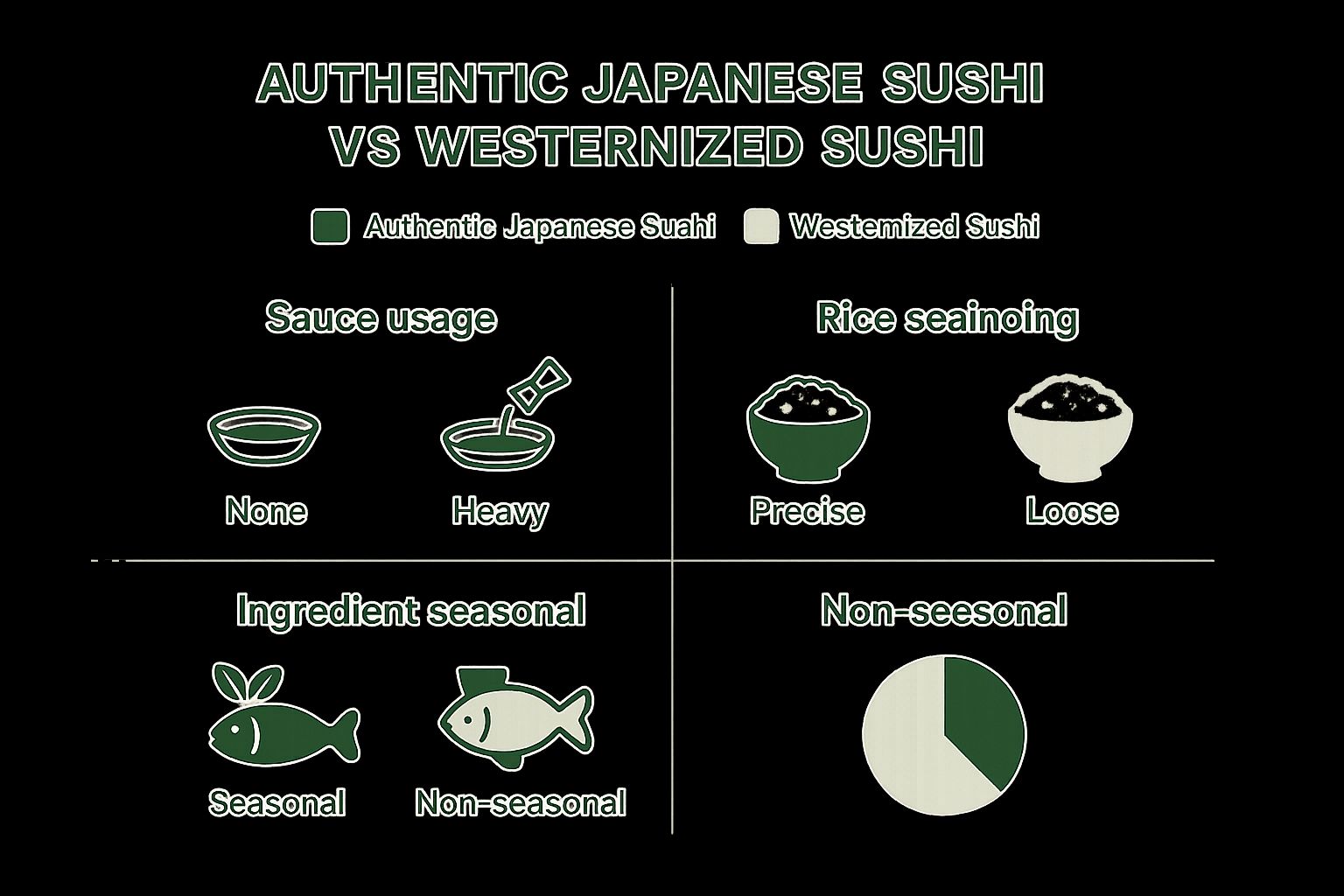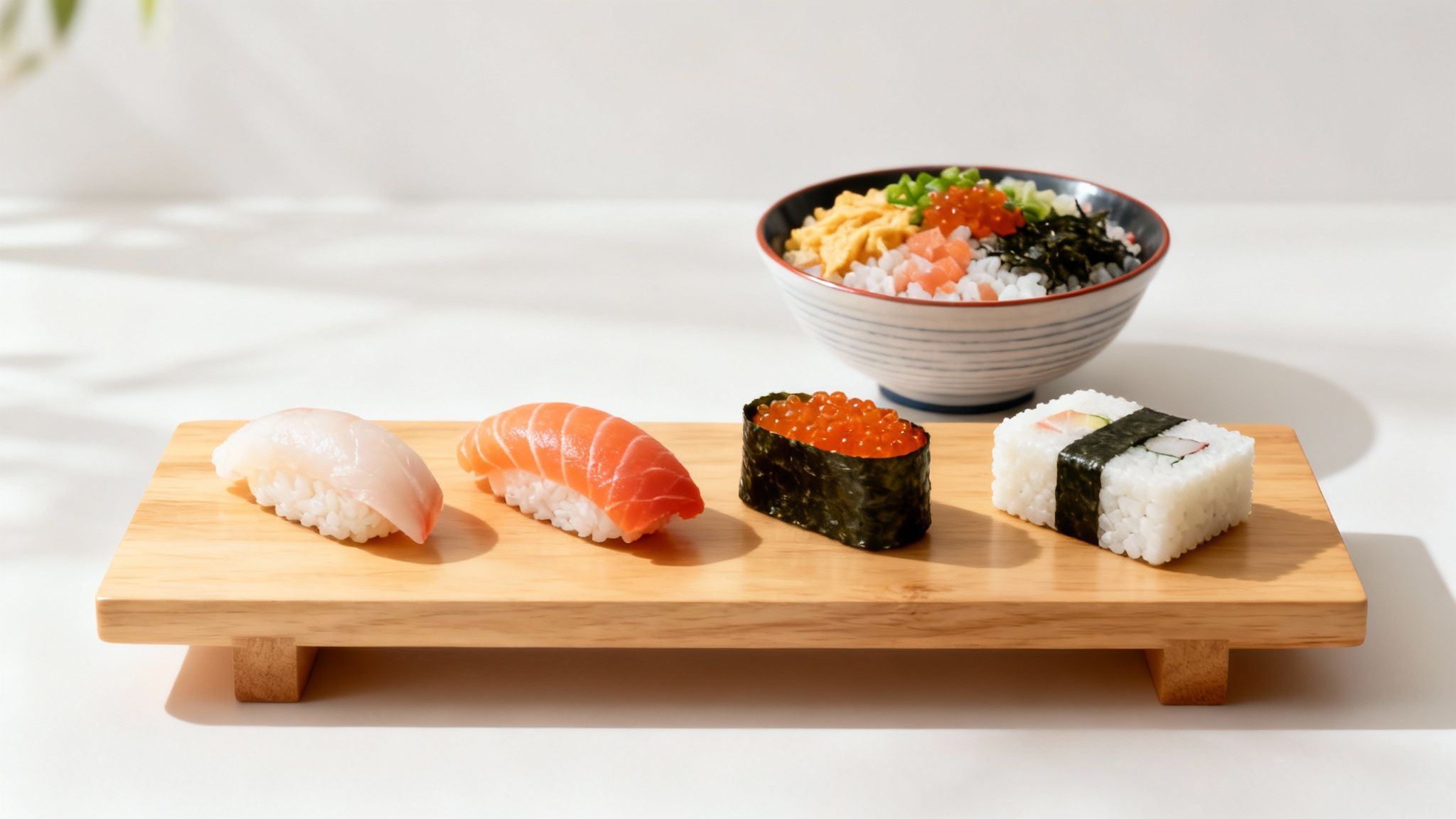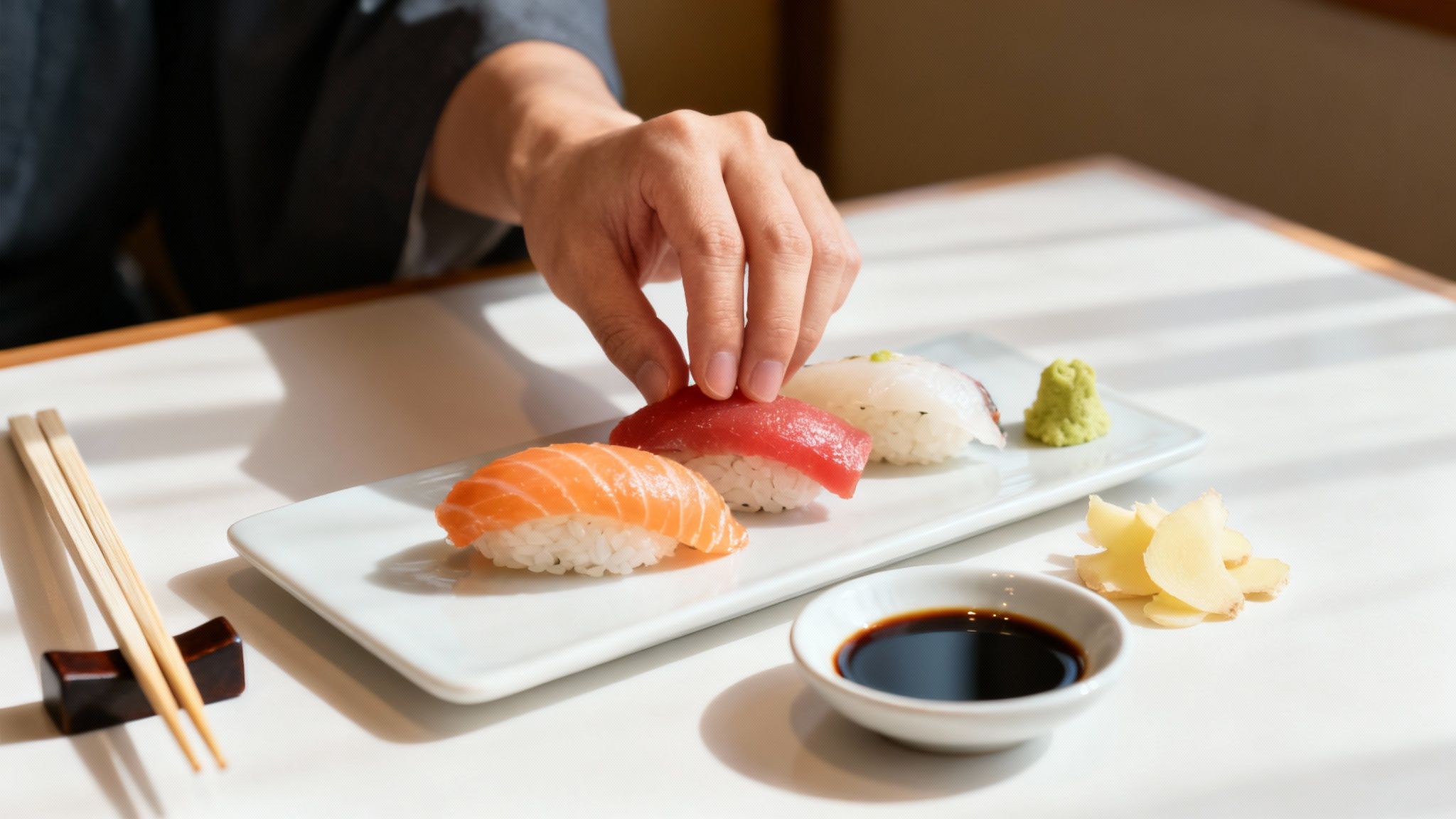Discover Authentic Japanese Sushi – A Culinary Delight
Authentic Japanese sushi is so much more than just raw fish and rice. It’s a genuine art form, one built on the pillars of balance, simplicity, and an unwavering respect for fresh, seasonal ingredients. The whole point is to elevate natural flavors, not bury them under heavy sauces or deep-fried additions. It’s a pure, clean, and harmonious way to eat.
What Makes Sushi Truly Authentic

When most of us outside Japan think of sushi, our minds often jump to those elaborate rolls packed with cream cheese, avocado, and tempura, all zigzagged with spicy mayo. And hey, those can be delicious! But they’re a world away from the principles that define traditional Japanese sushi.
At its core, authentic sushi is all about minimalism and precision. It’s guided by a Japanese aesthetic principle called shibui—a concept that champions simple, subtle, and understated beauty. The goal isn’t to see how much you can add, but how much you can take away to let the quality of each ingredient speak for itself. It’s this philosophy that turns a simple meal into something truly special.
The Harmony of Shari and Neta
The very soul of authentic Japanese sushi is the perfect marriage of two elements:
- Shari: This is the seasoned sushi rice, and it’s the foundation of everything. It isn’t just plain steamed rice; it’s carefully prepared with a delicate mix of rice vinegar, sugar, and salt. A true sushi chef, an itamae, can spend years just perfecting the texture, temperature, and taste of the shari.
- Neta: This is the topping—most often a pristine slice of high-quality seafood. The choice of neta is dictated by the seasons, which guarantees you’re getting it at its absolute peak of freshness and flavor.
The true measure of authentic sushi isn’t how many things are crammed into a roll, but how perfectly the shari supports and complements the neta. It’s a quiet conversation between two components, where neither shouts over the other, creating a single, perfectly balanced bite.
Elevating, Not Masking Flavors
Another huge difference is how sauces and condiments are used. In many Western-style rolls, sauces are there to create a big, bold flavor explosion. In authentic sushi, they’re used sparingly, if at all.
A delicate brush of soy sauce or the tiniest dot of wasabi is only there to enhance the natural umami of the fish, not to hide it. This minimalist approach can feel quite different from the fusion-style dishes many of us are used to. If you’re curious about how these culinary traditions blend and borrow from each other, understanding the difference between Pan-Asian vs. Asian fusion cuisine is a great place to start.
Ultimately, authentic sushi invites you to slow down and appreciate nuance, celebrating ingredients in their purest form.
The Foundational Pillars: Rice and Fish
While the dazzling array of toppings might catch your eye, the heart and soul of authentic Japanese sushi rest on two humble yet profoundly important pillars: the rice (shari) and the main topping, usually fish (neta). Getting these two elements right isn’t just a step in the process; it is the process. This dedication is what separates a forgettable meal from a truly memorable one.
Think of it like an orchestra. The neta might be the lead violin—beautiful and prominent—but the shari is the entire string section. It provides the body, rhythm, and emotional depth that makes the performance whole. Without perfectly executed rice, even the highest-quality fish will fall flat.
The Art and Soul of Shari
In true sushi, rice is never just rice. Shari is the name for meticulously prepared short-grain rice seasoned with a precise blend of rice vinegar, sugar, and salt. This seasoning, known as sushizu, is what originally gave sushi its name and its preservative qualities.
The process is a ritual in itself:
- Selection: Only premium Japanese short-grain rice will do. Its high starch content gives it that ideal sticky-yet-distinct texture needed to hold its shape without turning to mush.
- Washing: The rice is washed repeatedly in cold water until the water runs almost completely clear. This removes excess surface starch, which is the secret to avoiding a gummy texture.
- Cooking: The rice is cooked with a very specific water-to-rice ratio to achieve the perfect firmness. Beyond traditional techniques, a modern sushi kitchen relies on efficient equipment; exploring commercial rice cooker options is key for consistency.
- Seasoning: While still hot, the cooked rice is transferred to a hangiri—a traditional shallow, flat-bottomed wooden tub. The sushizu is drizzled over it, and the rice is quickly folded and fanned to cool it down. This allows each grain to absorb the seasoning and develop a beautiful, glossy sheen.
The ideal shari is served at body temperature, never cold. Each grain should be distinct with a slight al dente bite, and the flavor should be a delicate balance of sweet, salty, and acidic—just enough to complement the neta without overpowering it.
This infographic really drives home the key differences in preparation between authentic Japanese sushi and its Westernized cousins.

You can see how authentic sushi values precision and natural flavors, a stark contrast to the heavy-handed approach often found in Western rolls.
Neta and the Celebration of Seasons
If shari is the soul of sushi, then neta is its spirit. This is the topping, and in traditional sushi, its quality is non-negotiable. The selection of neta is guided by a core Japanese principle called shun (旬), which means eating ingredients at the absolute peak of their season when they are most flavorful.
An itamae’s knowledge of shun is encyclopedic. They know that fatty tuna (otoro) is best in the winter, sea bream (tai) shines in the spring, and horse mackerel (aji) hits its stride in the summer. This deep connection to nature ensures every piece of sushi offers the best possible taste. We explore a similar philosophy in our guide on seasonal sourcing from local farmers markets.
The preparation of neta is just as critical. It’s not always about serving it fresh off the boat. Some fish, like tuna or flounder, actually benefit from a period of aging. This controlled process, much like aging prime beef, breaks down enzymes in the fish, intensifying its umami flavor and creating a more tender, melt-in-your-mouth texture.
The final touch is the cut. A chef’s knife skills are paramount, as different slicing techniques are used to highlight the unique texture and grain of each type of fish. A single, precise, clean cut ensures the fish drapes perfectly over the shari, creating that harmonious bite that defines authentic Japanese sushi.
To really see the difference, let’s compare what goes on top of the rice in both worlds.
Authentic Neta vs Westernized Toppings
| Characteristic | Authentic Japanese Sushi (Neta) | Westernized Sushi (Toppings/Fillings) |
|---|---|---|
| Philosophy | Simplicity and purity; highlight the ingredient’s natural flavor. | Complexity and bold flavors; often combining multiple ingredients. |
| Key Ingredients | High-quality raw or cured seafood, egg omelet (tamago), eel. | Cream cheese, avocado, imitation crab, fried items (tempura). |
| Sauces | Used sparingly, if at all. A light brush of soy sauce or nikiri. | Heavy use of spicy mayo, eel sauce, sriracha, and other drizzles. |
| Focus | The quality and seasonality of a single main ingredient. | Creating a flavor explosion with many contrasting tastes and textures. |
| Examples | Maguro (tuna), Sake (salmon), Hamachi (yellowtail), Uni (sea urchin). | Philadelphia Roll, California Roll, Dragon Roll, Dynamite Roll. |
This table clearly illustrates the shift in focus—from celebrating a single, perfect ingredient to creating a complex, sauce-driven flavor profile. Both have their place, but they represent two very different culinary philosophies.
Exploring Traditional Sushi Forms

When most of us picture sushi, the classic seaweed-wrapped maki roll is what comes to mind. But that’s just the opening act. The world of authentic Japanese sushi is incredibly deep and varied, with each traditional form telling its own story about history, ingredients, and culinary purpose.
Getting to know these classic styles is like moving from a great band to a series of stunning solo artists. Instead of complex rolls packed with ingredients, the focus shifts to showcasing the pristine quality of the fish and the perfect texture of the seasoned rice. Each piece shines on its own.
Nigiri: The Quintessential Bite
Nigiri-zushi, or just nigiri, is arguably the most iconic form of sushi out there. Its beauty is in its elegant simplicity: a small, hand-pressed mound of seasoned rice (shari), draped with a single, masterfully sliced piece of topping (neta).
A true itamae (sushi chef) often adds a tiny dab of wasabi between the rice and fish and might brush the topping with a thin layer of nikiri, a sweet soy glaze. That means you usually don’t need any extra soy sauce. Each piece is a self-contained, perfectly balanced bite designed to be savored in one go.
A well-made nigiri is the ultimate test of a chef’s skill. The rice should be just firm enough to hold its shape, yet so delicate it seems to fall apart in your mouth, creating a seamless, melt-in-your-mouth experience with the fish.
Sashimi: Purity on a Plate
Alright, technically, sashimi isn’t sushi because it has no rice. But it’s an absolutely fundamental part of any traditional sushi experience. It’s often served as the first course, allowing you to appreciate the pure, unadulterated flavor of the seafood.
Sashimi is simply pristine, raw fish or seafood, sliced with incredible precision. The cut is everything—it changes depending on the type of fish to enhance its natural texture and taste. It’s typically served with a side of soy sauce for dipping, wasabi, and pickled ginger (gari).
Chirashi: Scattered Treasure in a Bowl
Chirashi-zushi, which literally means “scattered sushi,” is a feast for the eyes. It’s a vibrant bowl of perfectly prepared shari topped with an artful arrangement of various fish, vegetables, and other garnishes.
This style delivers a beautiful mosaic of colors, textures, and flavors all in one place. You’ll often find toppings like:
- Slices of tuna, salmon, and yellowtail
- Sparkling orange salmon roe (ikura)
- Sweet, layered egg omelet (tamago)
- Cool cucumber and fragrant shiso leaves
Chirashi is a popular choice for celebrations and home-style meals in Japan. It’s a less formal but equally delicious way to enjoy the core components of authentic sushi.
Oshi-zushi: The Pressed Sushi of Osaka
Hailing from the Kansai region, especially Osaka, oshi-zushi offers a completely different look and feel. Known as “pressed sushi,” it’s made by layering cured or cooked fish and seasoned rice into a rectangular wooden mold called an oshibako.
Pressure is applied to compact the layers, creating a dense, almost cake-like block of sushi. This block is then removed from the mold and sliced into neat, bite-sized rectangles. This method was actually developed before refrigeration as a way to preserve fish, and it remains a beloved regional specialty today.
While these traditional forms have stood the test of time, the way we enjoy them keeps evolving. From digital ordering to a growing demand for sustainable and plant-based options, global trends are reshaping the sushi industry. As consumers look for more unique dining experiences, restaurants are pushed to innovate. This adaptability ensures the art of sushi continues to thrive, as detailed in reports on the future of the sushi market on GlobeNewswire.
Mastering Sushi Etiquette and Dining

Enjoying authentic Japanese sushi is so much more than just a meal. It’s a cultural experience, steeped in tradition and a deep respect for the chef’s craft. Getting a handle on the etiquette transforms your dinner from just eating into a true appreciation of the art form. These aren’t rigid, stuffy rules; they’re customs designed to maximize flavor and honor the painstaking work behind each piece.
Think of the sushi chef, the itamae, as an artist presenting their masterpiece. Every single piece of nigiri is built to deliver a perfect symphony of flavor, texture, and temperature. Following proper etiquette ensures you experience that bite exactly as the artist intended, making the whole meal more memorable and meaningful.
Using Condiments Correctly
One of the most common mistakes people make at a sushi bar involves going overboard with the condiments. In a truly authentic setting, less is always more. The goal is to complement the fish, not drown out its delicate, nuanced flavor.
Here’s the right way to approach the holy trinity of sushi condiments:
- Soy Sauce (Shoyu): Pour just a tiny puddle into your dish—you can always add more. When dipping nigiri, gently turn it on its side and dip the fish side only. Never dip the rice. The rice is like a sponge; it will soak up way too much shoyu, making it salty and causing the whole piece to fall apart.
- Wasabi: Any skilled itamae has already placed the perfect amount of wasabi between the rice and the fish. Adding more is usually unnecessary and can even be seen as an insult to the chef’s carefully crafted balance. If you absolutely need more of a kick, place a tiny dab directly on the fish itself.
- Pickled Ginger (Gari): This isn’t a topping for your sushi. Gari is meant to be eaten between different pieces of fish. Its sharp, sweet flavor is a palate cleanser, resetting your taste buds so you can fully appreciate the unique profile of the next piece.
Chopsticks Versus Hands
How you get the sushi from the plate to your mouth also matters, and you might be surprised to learn what’s considered traditional. While different types of sushi have their own guidelines, nigiri is a special case.
It is perfectly acceptable—and often encouraged—to eat nigiri with your hands. This traditional method allows you to feel the texture and keeps the delicate construction of rice and fish intact, which can be tricky with chopsticks.
For sashimi or scattered chirashi bowls, chopsticks are definitely the way to go. The key is to be confident in your choice and handle the sushi gently, whether with your fingers or chopsticks. This respect for the food is a core part of the authentic experience.
Finally, each piece of sushi, especially nigiri, is designed to be a single, perfect mouthful. Eating it in one bite is essential. This allows all the carefully balanced components—the seasoned rice, the fresh fish, the hint of wasabi—to harmonize in your mouth, delivering the complete flavor profile the chef designed. Resisting the urge to take two bites will elevate your dining experience from good to exceptional.
How to Find an Authentic Sushi Restaurant
With the explosive popularity of Japanese food, a sushi spot seems to be on every corner. But as you now know, not all sushi is created equal. So how do you cut through the noise of fusion rolls and all-you-can-eat buffets to find a truly authentic Japanese sushi experience?
It’s less about luck and more about knowing what to look for. Think of it like being a detective—you’re searching for subtle clues that signal a real dedication to craftsmanship over mass-market appeal. Often, the best places aren’t the flashiest; they’re the understated gems that let the quality of the food do all the talking.
The Menu Tells a Story
Your first and most powerful clue is the menu. An authentic sushi-ya (sushi restaurant) will almost always have a smaller, more focused menu. This isn’t a sign of limitation; it’s a mark of specialization and, frankly, confidence.
A massive, book-like menu loaded with dozens of complex rolls with names like “Dragon,” “Volcano,” or “Dynamite” is often a red flag. These spots are usually catering to a Western palate that prioritizes big, bold flavors and heavy sauces. Instead, look for a menu that prominently features classic nigiri, sashimi, and simple maki, highlighting the names of the fish available that day.
Another dead giveaway is seasonality. A true master chef, or itamae, builds their offerings around shun—the Japanese concept of eating with the seasons. If a menu lists the exact same fish year-round, there’s a good chance they’re relying on frozen, lower-quality products.
Observe the Itamae and the Bar
The heart of any great sushi restaurant is the sushi bar, and its soul is the itamae standing behind it. If you can, always choose to sit at the bar. This front-row seat gives you invaluable insight into the restaurant’s quality and philosophy.
Here’s what you should be watching for:
- A Visible Chef: An authentic spot is proud to showcase its chefs at work. The itamae should be focused, precise, and confident in their movements.
- Knife Skills: Watch how the fish is handled. A skilled chef uses long, elegant slicing knives (yanagiba) to cut fish in a single, fluid motion—a technique that preserves its delicate texture.
- The Rice: Take a look at the shari (sushi rice). It should be kept in a wooden tub (hangiri), not a metal pot or plastic container, and served at body temperature—never cold.
- Interaction: A great itamae is knowledgeable and often happy to guide you. They might suggest what’s best that day, a practice known as omakase, or “I’ll leave it up to you.”
When you see an itamae working with calm, practiced efficiency—forming nigiri with just a few swift motions—you are witnessing an artist at work. This visible dedication to craft is one of the surest signs of an authentic establishment.
Red Flags to Watch Out For
Just as there are signs of quality, there are clear warnings that you might not be in for an authentic experience. The global sushi restaurant market is booming, valued in the range of $5-10 billion USD, and this growth has led to many places that prioritize trends over tradition. You can learn more about the global sushi market on Market Report Analytics.
Be wary of these red flags:
- Overuse of Sauces: If every plate comes out drizzled in spicy mayo and eel sauce, it’s often to mask the flavor of less-than-premium fish.
- “Spicy Tuna” Abundance: While popular, a menu dominated by spicy tuna—often made from scraps mixed with mayonnaise—is a clear sign of a Westernized approach.
- Distinguishing Cuisines: Make sure the restaurant specializes in Japanese cuisine. While some places offer multiple Asian cuisines, a true sushi-ya is dedicated solely to the art of sushi. Understanding the difference between Chinese and Japanese food can help you recognize this focus.
By keeping these tips in mind, you can confidently step into a restaurant and know whether you’re about to enjoy a simple meal or a true culinary experience.
Common Questions About Authentic Sushi
Stepping into the world of authentic Japanese sushi can spark a few questions, especially if you’re more familiar with the elaborate rolls popular in the West. Let’s clear up some of the most common curiosities so you can feel more confident and in the know.
Think of it as fine-tuning your sushi radar, making sure the core principles of tradition, freshness, and balance are crystal clear.
Authentic vs. American-Style Sushi
So, what’s the biggest difference between the real deal from Japan and the American-style rolls we see everywhere? It really comes down to their core philosophy. Authentic Japanese sushi is all about simplicity and balance. The entire goal is to put the spotlight on the incredible natural flavor of just a few top-tier, seasonal ingredients—especially the perfectly seasoned rice and the pristine fish.
American-style sushi, on the other hand, is a different beast altogether. It’s all about big, bold flavors, complex combinations, and flashy presentations. You’ll often find multiple sauces, fried tempura bits, and non-traditional ingredients like cream cheese or avocado piled high. It’s a hugely popular culinary experience, just a completely different one.
Is It Rude to Use a Fork?
Absolutely not. While a fork isn’t traditional, most restaurants will happily give you one if you ask. There’s no reason to feel awkward about it. That said, if you’re up for it, trying chopsticks is a great way to fully immerse yourself in the experience.
Here’s a pro tip: for nigiri sushi, using your hands is not just okay—it’s completely traditional. It’s often the preferred way to eat it, as it keeps the delicate rice and fish perfectly intact from the plate to your mouth.
Why Is Authentic Sushi So Expensive?
The price tag on high-quality, authentic sushi comes down to two things: phenomenal ingredients and incredible skill. First, there’s the cost of sourcing exceptionally fresh, high-grade seafood. This isn’t just any fish; it requires meticulous handling and is often flown in from specific markets.
The second, equally important factor is the itamae (sushi chef) themselves. These chefs undergo years, sometimes decades, of intense training to master their craft. You’re not just paying for premium fish; you’re paying for the artistry, precision, and deep knowledge that goes into making each and every piece perfect.
The Difference Between Sushi and Sashimi
This is a classic point of confusion, but the answer is surprisingly simple: rice. The word “sushi” always, always refers to a dish made with vinegared rice, known as shari. It doesn’t matter if it’s nigiri (a slice of fish over rice), maki (a roll), or chirashi (a bowl of rice with toppings)—if it has that special rice, it’s sushi.
Sashimi, on the other hand, is simply expertly sliced raw fish or seafood served all by itself, with no rice in sight. While they’re often served together and both showcase premium seafood, sashimi technically isn’t a type of sushi at all.
Ready to experience a truly personalized and unforgettable meal? At Culinary Collective Atl, our private chefs specialize in creating bespoke dining journeys right in your own home. Discover the art of fine dining, tailored just for you, by visiting us at https://www.theculinarycollectiveatl.com.





